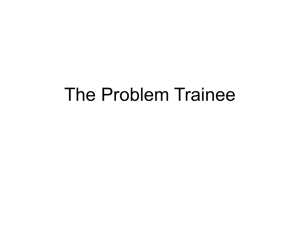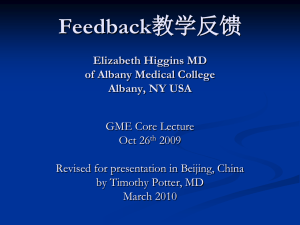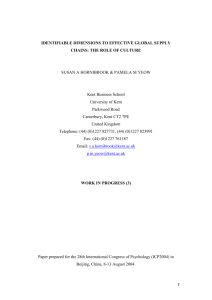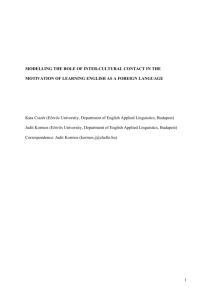Evaluation of Training
advertisement
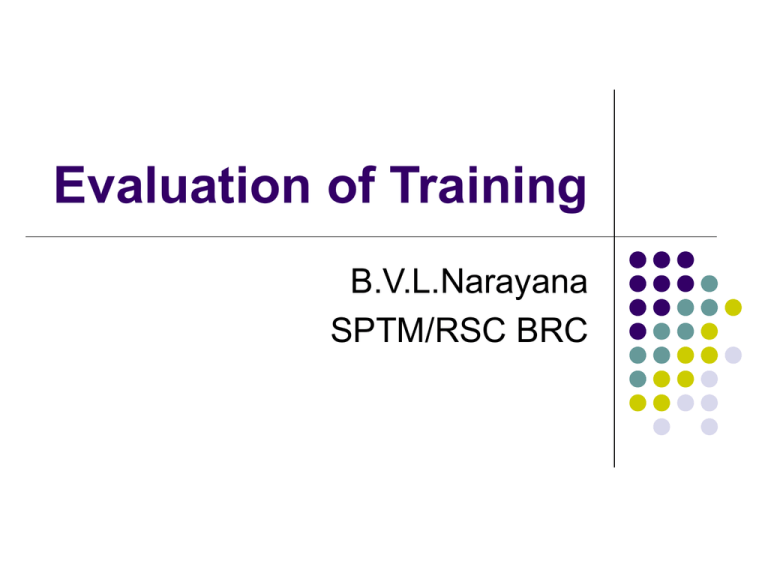
Evaluation of Training B.V.L.Narayana SPTM/RSC BRC DEFINITION Training Provision aimed at creating intentional learning processes To bring about semi permanent change in individuals – Knowledge, attitudes. Skills and habits (KASH)—behaviors With an intention To enhance performance on the job Evaluation of training Systematic collection of descriptive and judgmental information necessary to make effective training decisions Is affected by Need analysis, participation, other antecedent conditions, design and delivery and transfer of training Evaluation of training Antecedent conditions Design and delivery Are what trainees bring to training Structuring and methods of delivering content Transfer of training Transfer of training is defined as the degree to which trainees apply the knowledge, skills , and attitudes gained in training to their job ( Ford and weissbein 1997; Tannebaum and Yulk 1992; Wexley and latham 1991) TRAINING AND TRANSFER Learning and skill development Achieve orgn results Achieve self results Knowledge transfer and utilisation Sharing to learn and use Factors affecting transfer and use Facilitation Transfer and use Personality Evaluation criteria Individual learning and use Linked rewards and punishments Training and transfer Knowledge, concepts Attitudes Ability to do roles ACQUISITION Skills Motivation to learn Habits TRAINING Improved performance UTILISATION AT JOB Motivation to transfer Transfer of training For individual performance Present job Future job Sharing Organisational strategy, individual strategy Transfer of skills to others Participation Factors influencing participation Organizational Alignment with organizational strategy Change, innovative work practices High performance work systems In large organizations At job level Economies of scale, work place recognition, union involvement, specialized skills Showing greater support for training and development Highly skilled jobs At individual level More motivated to learn, continuous learning More committed Antecedent conditions Are What trainees bring to training High cognitive ability High motivation to learn-desire to learn High training and performance goal orientation Work environment factors-facilitating trainee participation and learning Enablers of use of training at work place Rewards, recognition, support, resources Organizational direction and support How training is prepared Content has to be relevant, interesting, appropriate and have opportunities for practice, enable mental conceptualization of material Motivation to learn Motivation to learn is defined as the specific desire of a learner to learn the content of training programme (Noe 1986; Noe and Scmitt 1986) –supported by High training goal orientation Lack anxiety High internal locus of control High achievement motivation Conscientitious High self efficacy Committed Plan their career Organizational support, peer and supervisor support Training design Is based on how people learn and how organizations learn Learning cycles (Sanchez 2002) Learning principles (Kolb 1984) Recall from memory Apply principles to task Symbolic mental rehearsal Reinforcement Feed back and response Self monitoring of learning Cater to differences in aptitudes Design of training Learner control Trainer skills Enabling trainee to participate in design of programme Has a very small role, good for procedural and skill based learning Use of line managers, peers unskilled trainers reduces efficacy of training Use expert and skilled trainers Question of outsourcing Issues of trust, contextual familiarity, commitment Types of training Individual, team, error and e-learning Delivery Contexts Separate As part of high performance work systems Influenced by Trainees learning style Methodology of delivery Way training is delivered-Kolb’s experiential learning cycle(1984) – concrete experience, reflective observations, abstract generalization, active experimentation Specific population and content Maximum transfer of training occurs when conditions for transfer are included in training, practice scenarios, trainee is allowed to set goals, gets rewards and trainee supervisors are trained Methodologies Groups of methods used in training Information presentation Modeling- demonstration Information presentation and learner response— case method Systematic response generation—contextualizing the training Simulation On the job training High performance work systems A growing body of research suggests that the use of a set of HR practices, including comprehensive employee recruitment selection procedures, compensation and performance management systems, information sharing, and extensive employee involvement and training, can improve the acquisition, development and retention of a talented and motivated workforce. These HR practices are usually referred to as high involvement, high commitment, or high performance work systems. Training design Involves five steps Specify instructional objectives Decide sequence of activities Select training method Ensure good learning environment Content based on learning principles To maintain motivation to learn Design measures of training effectiveness Transfer of training Aims of transfer Apply to improve performance Immediate—learn and apply Long term –maintain and apply, transfer to others Is impacted by factors What occurs before training What occurs during training What occurs after training Factors classified as Individual organizational Transfer of training Individual Learner characteristics Cognitive ability Motivation to learn Anxiety Openness to experience Perceived utility Career planning Organizational commitment High motivation to transfer Transfer of training Training environment Learning goals Content relevance Practice and feed back Behavioral modeling Error based examples Work environment Transfer climate Supervisor support Peer support Opportunity to perform Evaluation of training Most commonly based on four stages model Four stages of evaluation Kirkpatrick (1959,1976,1994,2006) Reactions Learning Behavioral Results Research shows that most used is Reactions (72%), followed by learning( 32%) behavioral ( 19%) and results (7%) Evaluation of training Category Definition Methods Time lag Key issues Reactions Affective attitudinal responses Self report measures immediate Not related to trainee learning and transfernot utility based Learning programme outcomes Paper pencil test 25-30days Necessary for performance Behavioral Actual Supervisor 4-6 performance ratings months on job Susceptible to environment variables Results Are monetary benefits Are most distant, difficult to correlate Utility analysis 6-8 months Evaluation of training Research Very few to establish causal sequence of Kirkpatrick's model New models are being developed Holton's model Proof that training helps Immediate Long term Evaluation of training SECONDARY INFLUENCES-Performance self efficacy, learner readiness ENVIRONMENTAL ELEMENTS-Feed back, Peer supposrt, Supervisor support, Openness to change MOTIVATIONAL ELEMENTS-Motivation to transfer, Transfer effort performance expectations, Performance to outcomes expectations Personal outcomes positive, Personal outcomes negative and Supervisor sanctions LEARNING INDIVIDUAL PERFORMANCE ABILITY -Content validity, Transfer design, Personal capacity to transfer, Opportunity to use ORGANISATIONAL RESULTS Evaluation of training Personality characteristics Intervention readiness Intervention fulfillment Secondary influences Job attitudes Motivation elements Environmental elements Outcomes Ability / enabling elements Motivation to Learn Reaction Learning Ability Motivation to transfer Transfer climate Individual performance Transfer design Expected utility / ROI External events Organisational results Linkage to organisational goals Theory of planned behavior Attitude towards the behaviour Intention Subjective norm Perceived behaviour control Behaviour Theory of planned behavior The theory of planned behaviour states that the most important determinant of a persons behaviour is behaviour intent ( Ajzen 1991; Ajzen and Fishbien 1980; Fishbien and Ajzen 1975) and that this intent is dependent upon His attitude, the pervailing norms and perceived behaviour controls. Peoples attitudes towards their behaviour refers to the degree to which they are made favourable or unfavourable evaluations of behaviour in question. subjective norms are perceived social pressures from significant others to perform or not to perform. Perceived behavioral controls are the perceived ease or difficulty of performing a beaviour. more favourable the norms and attitudes, more favourable is te perceived beavioural controls and stronger the individual intention to perform the behaviour under consideration Beliefs Performance Skills Actions THANKS ANY QUESTIONS
